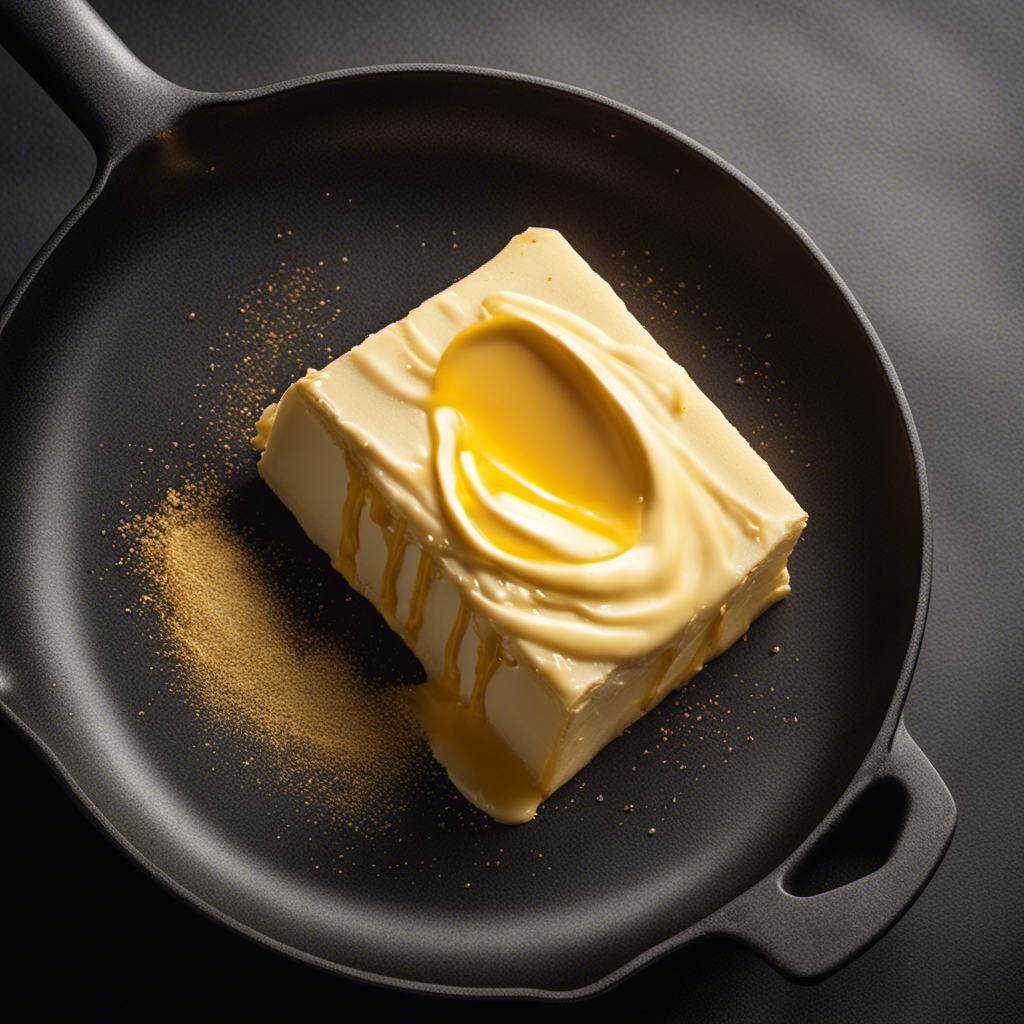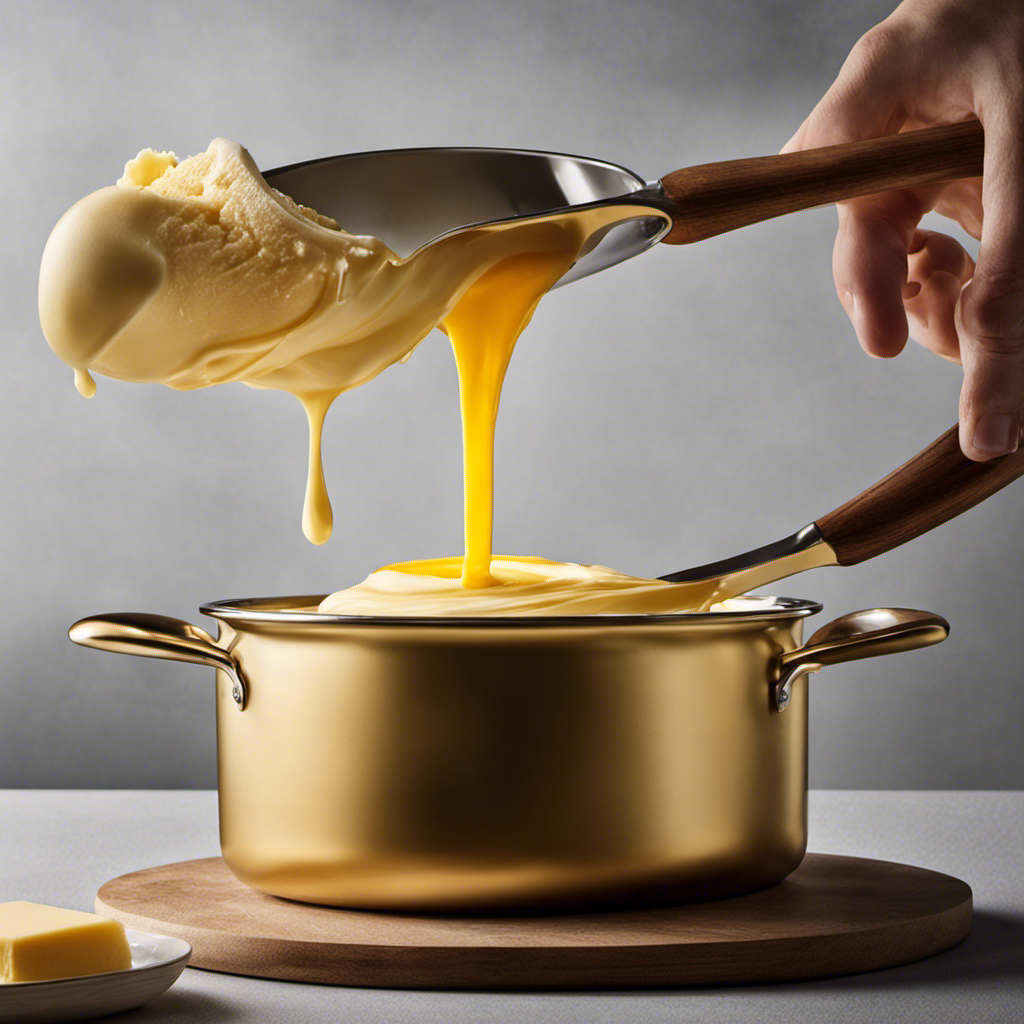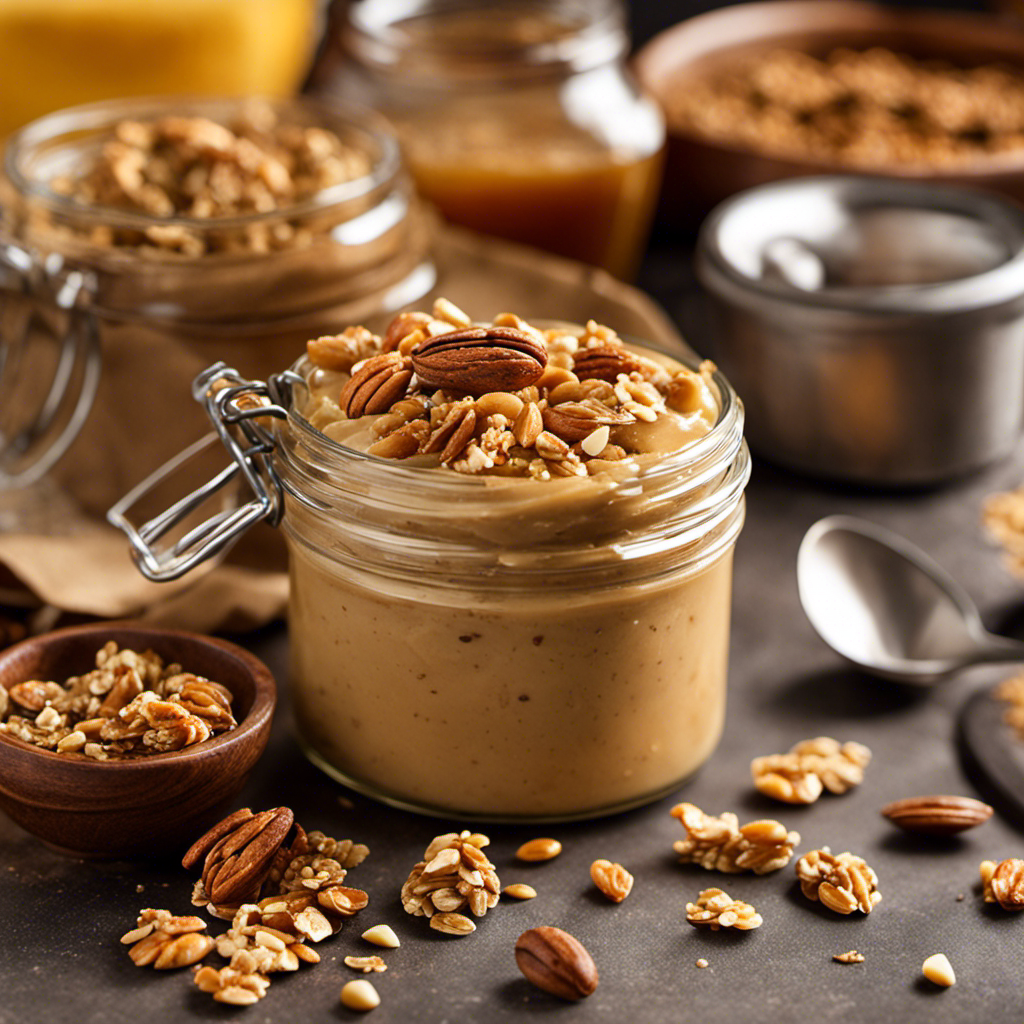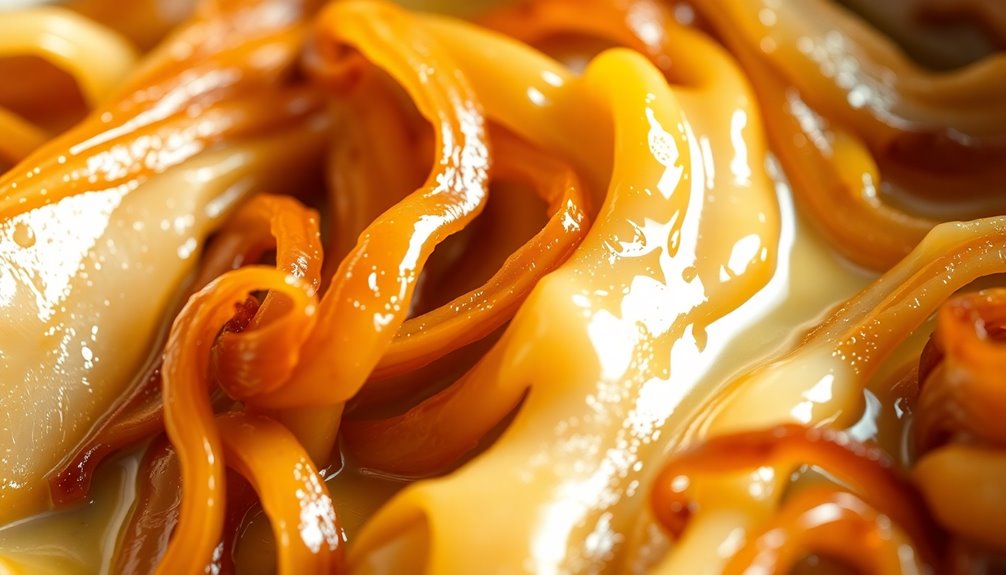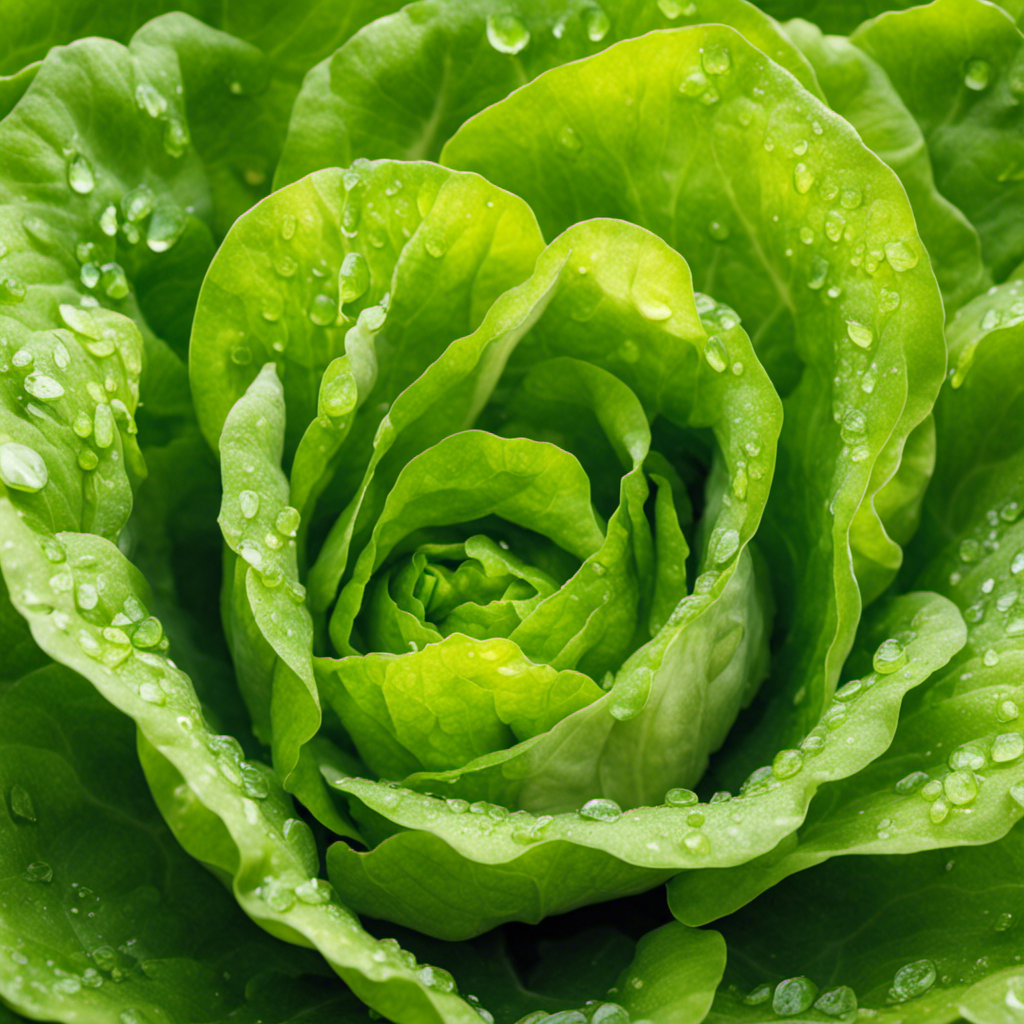I have always been fascinated by the science of cooking, especially the complex relationship between temperature and ingredients.
One thing that never fails to surprise me is how quickly butter can go from creamy and golden to a burnt mess.
In this article, we’ll delve into the precise temperature at which butter burns and explore the factors that contribute to this culinary catastrophe.
So, grab your apron and let’s dive into the smoky world of burnt butter.
Key Takeaways
- Butter burns when it reaches a certain temperature.
- The temperature at which butter burns is usually around 350°F (177°C).
- Clarifying butter raises its smoke point to around 450°F (232°C).
- The signs of burnt butter include a distinct and pungent smell, a dark brown or black color, and a nutty or acrid aroma.
The Science Behind Butter Burning
Butter burns when it reaches a certain temperature. Combustion of butter occurs when the heat applied to it causes the fats and proteins in the butter to break down and react with oxygen in the air. This process, known as the Maillard reaction, leads to the browning and charring of the butter.
The exact temperature at which butter burns can vary depending on factors such as the type of butter, its moisture content, and the heat source being used. However, generally, butter starts to burn around 350°F (177°C). At this temperature, the milk solids in the butter begin to caramelize, giving off a distinct burnt aroma and taste.
It is important to monitor the temperature carefully when cooking with butter to prevent it from burning and affecting the flavor of the dish.
Factors Affecting Butter’s Burn Point
To avoid burning it, you need to consider certain factors that affect when butter reaches its burn point. Here are four key factors that can influence the burn point of butter:
-
Temperature: Butter has a relatively low smoke point, usually around 350°F (177°C). Heating it above this temperature can cause it to burn quickly.
-
Clarification: Clarifying butter removes the milk solids, raising its smoke point to around 450°F (232°C). This makes it more resistant to burning.
-
Type of butter: Different types of butter have different smoke points. For example, cultured butter has a higher smoke point than regular butter.
-
Cooking method: The cooking method you choose can also affect butter’s burn point. For instance, using gentle heat or adding other ingredients can help prevent butter from burning.
Identifying the Signs of Burnt Butter
When it comes to identifying the signs of burnt butter, there are two key points to consider: the smell and the color change when it is burnt.
The burnt butter smell is distinct and pungent, often described as nutty or acrid.
Additionally, when butter is burnt, it undergoes a noticeable color change, turning dark brown or black.
Burnt Butter Smell
The burnt butter smell can linger in the kitchen for quite a while. It’s a distinct and unpleasant odor that can be hard to get rid of. However, there are a few steps you can take to prevent butter from burning and minimize the lingering smell:
-
Use low to medium heat: Butter has a low smoke point, so it’s important to cook it over gentle heat to prevent it from burning.
-
Watch it closely: Butter can go from perfectly golden to burnt in a matter of seconds, so keep a close eye on it while cooking.
-
Stir constantly: Stirring the butter helps distribute the heat evenly and prevents it from overheating in certain spots.
-
Remove burnt butter smell: If you do end up burning the butter, try these tips to remove the smell: open windows to let fresh air in, boil a pot of water with a few slices of lemon, or use air fresheners or odor-absorbing products.
Now, let’s delve into the next section and explore the color change that occurs when butter is burnt.
Color Change When Burnt?
You can easily notice a significant color change in the butter when it’s burnt. Butter typically starts as a pale yellow color, but as it reaches its temperature threshold and begins to burn, it transforms into a dark brown or black color.
This color change occurs due to the Maillard reaction, a chemical reaction that happens between the proteins and sugars in the butter when exposed to high heat. The intensity of the color change can vary depending on the temperature and duration of exposure to heat.
Burnt butter not only changes in color but also develops a distinct smoky aroma. The color change and burnt smell serve as indicators that the butter has reached its burning point.
Now, let’s explore some common culinary uses for burnt butter.
Common Culinary Uses for Burnt Butter
One of the most common culinary uses for burnt butter is in making decadent sauces. The process of browning butter enhances its flavor profile, giving it a nutty and caramel-like taste.
Here are four ways burnt butter can elevate your culinary creations:
-
Sauces: Burnt butter adds depth and richness to sauces like beurre blanc or hollandaise, making them more flavorful and luxurious.
-
Baked goods: Incorporating burnt butter into cookies, cakes, and pastries can impart a unique and irresistible flavor.
-
Vegetables: Drizzling burnt butter over roasted vegetables brings out their natural sweetness and adds a delightful complexity to the dish.
-
Pasta: Tossing cooked pasta in burnt butter creates a simple yet delicious sauce that coats each strand with a rich and savory flavor.
Tips for Preventing Butter From Burning
To prevent butter from burning, it’s important to keep the heat at a moderate level and continuously stir the butter while it melts. Butter has a low smoke point, typically around 350°F (177°C), which means it can easily burn if exposed to high heat. Here are some tips for preventing butter from sticking and controlling the heat while cooking with butter:
- Use a nonstick pan or add a small amount of oil to the pan before melting the butter.
- Cut the butter into small, evenly-sized pieces to help it melt more evenly.
- Use a moderate heat setting and adjust as needed to prevent the butter from overheating.
| Tips for Preventing Butter From Sticking | How to Control Heat While Cooking with Butter |
|---|---|
| Use a nonstick pan or add oil | Use a moderate heat setting |
| Cut butter into small, even pieces | Adjust heat as needed |
| Stir butter continuously while melting |
Butter Alternatives for High-Heat Cooking
Using alternative cooking fats, such as ghee or coconut oil, can be a suitable option for high-heat cooking. Here are four reasons why these butter substitutes, particularly ghee, are beneficial:
-
Smoke Point: Ghee has a higher smoke point compared to butter, making it more suitable for high-heat cooking. This means it can withstand higher temperatures without burning or releasing harmful compounds.
-
Nutritional Profile: Ghee is rich in fat-soluble vitamins like A, D, E, and K, which can support overall health. It also contains butyrate, a beneficial fatty acid that may have anti-inflammatory properties.
-
Flavor: Ghee has a unique and rich flavor, similar to butter. It adds a delicious taste to dishes, enhancing their overall appeal.
-
Shelf Stability: Ghee has a longer shelf life compared to butter. It can be stored at room temperature for months without spoiling, eliminating the need for refrigeration.
Frequently Asked Questions
How Does the Burning Point of Butter Compare to Other Cooking Oils?
Comparing the burning points of butter and vegetable oil, butter has a lower burning point due to its milk solids. When butter burns, it can produce harmful compounds. Therefore, consuming burnt butter is not recommended for health reasons.
Can Burnt Butter Affect the Taste of a Dish?
Burnt butter can ruin the taste of a dish, leaving a bitter and unpleasant flavor. To prevent this, use low heat, watch it closely, and consider using clarified butter in burnt butter recipes.
Is It Safe to Consume Burnt Butter?
It is generally safe to consume burnt butter, but it can affect the taste of a dish. However, there are butter alternatives that can be used to avoid this issue. Additionally, cooking with burnt ingredients can add a smoky flavor to certain dishes.
Can Burnt Butter Be Salvaged or Used in Any Other Way?
I love experimenting in the kitchen, especially when it comes to salvaging burnt butter. There are so many creative uses and recipes for it! The science behind its flavor profile is fascinating.
Are There Any Health Risks Associated With Consuming Burnt Butter?
There can be health implications associated with consuming burnt butter. When cooking, it’s important to prioritize cooking safety and avoid burning butter to minimize potential risks to our health.
Conclusion
In conclusion, understanding the temperature at which butter burns is crucial for every aspiring chef. By delving into the science behind it and considering the factors that affect its burn point, we can prevent the unpleasant taste and smell of burnt butter.
Identifying the signs of burnt butter is key to achieving culinary perfection, while also exploring alternative options for high-heat cooking. So remember, with a little knowledge and careful attention, you can elevate your cooking skills to new heights and avoid the bitter consequences of burnt butter.
After all, in the kitchen, precision and patience are the secret ingredients to success.
